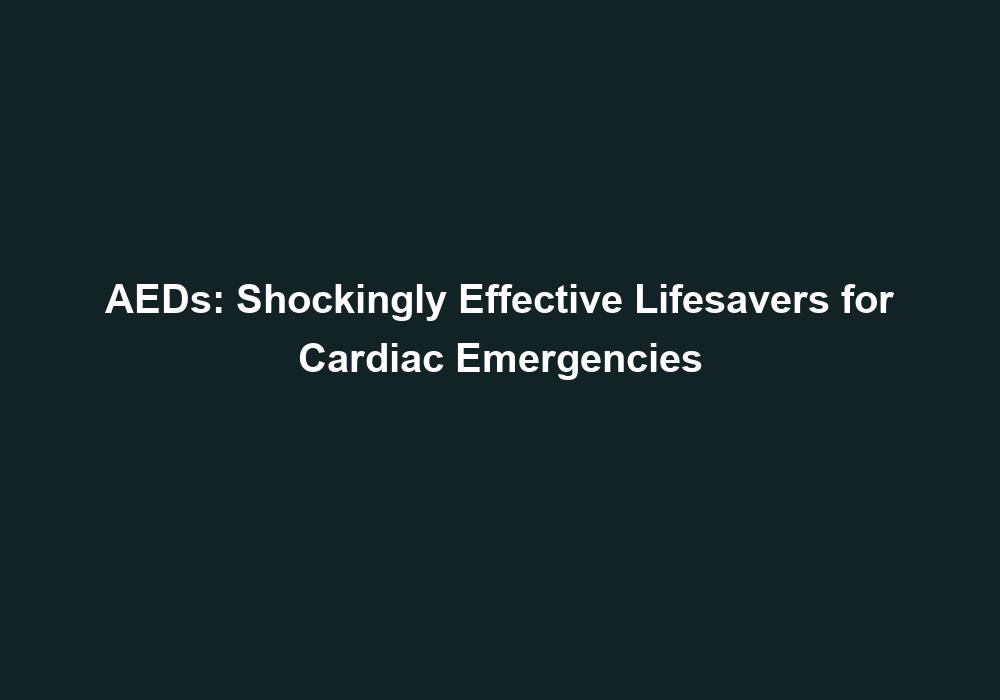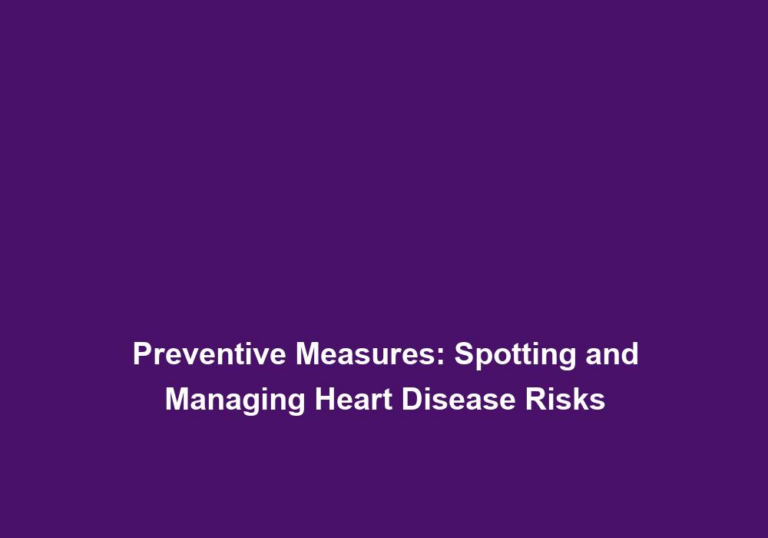AEDs: Shockingly Effective Lifesavers for Cardiac Emergencies
Cardiac emergencies can occur unexpectedly, and the immediate administration of life-saving measures is crucial in increasing the chances of survival. One such lifesaving tool that has revolutionized emergency response is the Automated External Defibrillator (AED). In this article, we will explore the importance of AEDs and how they have become shockingly effective in saving lives during cardiac emergencies.
The Role of AEDs in Cardiac Emergencies
-
Immediate Defibrillation: AEDs are designed to deliver a controlled electric shock to the heart during sudden cardiac arrest. This defibrillation process is vital as it helps restore the heart’s normal rhythm, allowing it to effectively pump blood throughout the body. By initiating defibrillation promptly, AEDs significantly improve the chances of survival.
-
User-Friendly Interface: AEDs are specifically designed to be user-friendly, ensuring that even individuals without medical training can effectively use them in emergency situations. These devices provide clear audio and visual instructions, guiding the rescuer through each step of the defibrillation process. The simplicity of the interface ensures that anyone can quickly understand and operate the AED, increasing the likelihood of successful treatment.
-
Portable and Accessible: AEDs are lightweight and portable, making them easily accessible in various settings, such as schools, airports, gyms, and public places. Their presence in these locations ensures that prompt defibrillation can be initiated until professional medical help arrives. The portability of AEDs allows for rapid deployment to any location within a facility or public space, reducing response times and potentially saving precious minutes that are critical for survival.
-
Time is of the Essence: During a cardiac emergency, every second counts. Research shows that for every minute that passes without defibrillation, the chances of survival decrease by 7-10%. AEDs significantly reduce the time it takes to initiate defibrillation, increasing the likelihood of a positive outcome. By delivering an electric shock promptly, AEDs restore the heart’s rhythm, preventing further deterioration and potentially saving a life.
Furthermore, it is important to note that AEDs are equipped with advanced features that enhance their effectiveness. These features include voice prompts that guide the rescuer through the entire process, ensuring that the correct steps are followed. Additionally, some AEDs have built-in sensors that analyze the heart’s rhythm and determine if a shock is necessary. These technological advancements further contribute to the overall effectiveness of AEDs in managing cardiac emergencies.
Understanding AED Operation
AEDs are designed to be user-friendly, allowing even non-medical professionals to administer life-saving treatment. Here is a breakdown of the steps involved in operating an AED:
-
Power On: To begin using an AED, simply turn on the device by pressing a clearly marked power button. This simple step activates the AED and prepares it for immediate use.
-
Attach Electrode Pads: Open the AED’s electrode pads package and carefully attach them to the victim’s bare chest. The pads are equipped with sensors that analyze the heart’s rhythm and provide vital information to the AED.
-
Stand Clear: Ensure that nobody is touching the victim, then press the button or follow the device’s instructions to analyze the heart rhythm. The AED will determine if a shock is necessary based on its analysis of the heart’s electrical activity.
-
Deliver the Shock: If the AED advises a shock, make sure no one is touching the victim and press the shock button. Some AEDs may deliver the shock automatically, while others require the rescuer to initiate the shock. It is crucial to follow the AED’s instructions and ensure everyone is clear of the victim before delivering the shock.
-
Perform CPR: After delivering the shock, the AED may instruct the rescuer to perform CPR (Cardiopulmonary Resuscitation) until medical professionals arrive. CPR involves chest compressions and rescue breaths, which help circulate oxygenated blood throughout the body. The combination of AED usage and CPR significantly improves the chances of survival during a cardiac emergency.
It is important to note that AEDs are designed to provide clear and concise instructions throughout the entire process. The voice prompts and visual cues ensure that even individuals with no prior medical training can confidently and effectively operate the device.
AEDs in Public Spaces
The widespread placement of AEDs in public spaces has proven to be a game-changer in improving survival rates during cardiac emergencies. Here’s why:
-
Increased Accessibility: Placing AEDs in public spaces ensures that these life-saving devices are readily available, reducing response times during emergencies. Whether it’s a shopping mall, a sports arena, or a park, the accessibility of AEDs can make all the difference, especially when every second counts. By strategically locating AEDs in easily accessible areas, the chances of finding one quickly during an emergency are significantly increased.
-
Bystander Empowerment: AEDs are designed to be used by anyone, irrespective of their medical background. By making AEDs easily accessible in public spaces, bystanders are empowered to take immediate action and potentially save lives. The intuitive interface and clear instructions provided by AEDs enable bystanders to confidently and effectively use the device until professional medical help arrives.
-
Public Awareness: The presence of AEDs in public spaces creates awareness about the importance of early defibrillation in saving lives. People who encounter AEDs in public areas are more likely to recognize their significance and understand their potential life-saving capabilities. This increased awareness can lead to more individuals seeking CPR and AED training, further strengthening the chain of survival and improving overall community preparedness in responding to cardiac emergencies.
It is worth highlighting that the placement of AEDs in public spaces should be accompanied by regular maintenance and training programs to ensure their optimal functionality and proper usage. Regular checks and inspections of AEDs, along with training sessions for designated personnel, can maximize the effectiveness of these devices in saving lives.
Importance of AED Training
While AEDs are designed to be user-friendly, it is essential for individuals to receive proper training in their operation. Here’s why AED training is crucial:
-
Confidence and Competence: Proper training instills confidence in individuals, enabling them to respond effectively during a cardiac emergency. Training ensures that users are comfortable with the AED’s operation and can act promptly without hesitation. By familiarizing themselves with the device and its features, individuals gain the confidence to initiate defibrillation and potentially save a life.
-
Optimal Device Utilization: AED training provides individuals with a comprehensive understanding of the device’s functionality. This knowledge ensures that the AED is utilized optimally, maximizing its potential to save lives. Training covers topics such as proper electrode pad placement, correct usage of the device’s features, and awareness of potential challenges that may arise during operation. This comprehensive understanding allows individuals to make the most effective use of the AED in emergency situations.
-
CPR Integration: AED training often includes CPR training, complementing the use of the device. This integration equips individuals with the necessary skills to perform CPR alongside AED usage, further increasing the chances of survival. CPR helps maintain blood flow and oxygenation to vital organs, while AEDs restore the heart’s rhythm. Together, these interventions significantly improve the chances of a positive outcome during a cardiac emergency.
By undergoing AED training, individuals become valuable links in the chain of survival. Their ability to recognize a cardiac emergency, initiate prompt AED usage, and perform CPR can greatly increase the chances of survival for someone experiencing sudden cardiac arrest.
The Future of AEDs
As technology continues to advance, so does the potential of AEDs in saving lives. Here are some exciting developments in the field:
-
Smart AEDs: Advancements in technology have led to the development of smart AEDs that provide real-time feedback during CPR. These devices can monitor the quality of chest compressions and ventilation, ensuring optimal resuscitation efforts. By providing immediate feedback, smart AEDs assist rescuers in delivering high-quality CPR, enhancing the chances of survival.
-
Enhanced Connectivity: Some AEDs now feature connectivity options, allowing emergency responders to remotely monitor the device, guide the user, and collect valuable data for post-event analysis. The ability to connect AEDs to a network enables emergency medical services to have real-time access to critical information, such as the device’s status, usage statistics, and patient data. This connectivity can revolutionize emergency response and improve outcomes by facilitating remote guidance and data-driven decision-making.
-
Integration with Emergency Services: Future AEDs may feature built-in connectivity with emergency medical services, allowing for seamless coordination between bystanders, AEDs, and emergency responders. These integrated systems can automatically alert emergency services when an AED is in use, providing crucial information about the location and status of the device. This integration streamlines the communication and collaboration between bystanders, AEDs, and professional medical personnel, ultimately improving the overall response to cardiac emergencies.
In conclusion, AEDs have emerged as shockingly effective lifesavers during cardiac emergencies. Their user-friendly nature, portability, and prompt defibrillation capabilities make them an invaluable tool in increasing survival rates. The widespread placement of AEDs in public spaces, coupled with proper training, empowers individuals to take immediate action, potentially saving countless lives. With ongoing advancements and integration with technology, the future of AEDs looks promising in further improving emergency response and outcomes.







